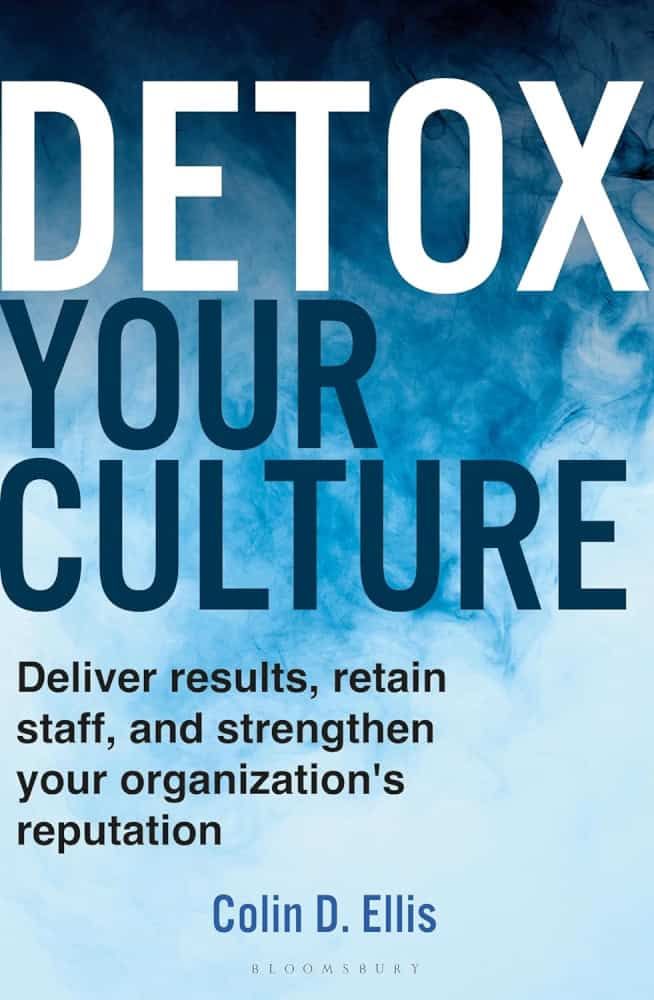In recent years, shocking reports of toxic workplaces have regularly made national headlines, not least concerning the Post Office Horizon Scandal.
It seems that everywhere you turn, there is a similar high-profile workplace scandal that’s being aired in public, from the Metropolitan Police and Confederation of British Industry (CBI) to the Nursing and Midwifery Council (NMC) and even Westminster.
But it would be wrong to think that these are isolated incidents or limited only to the biggest organisations.
As new business guide Detox Your Culture: Deliver results, retain staff, and strengthen your organization’s reputation by bestselling author and globally respected workplace culture expert Colin D. Ellis observes, toxic culture in the workplace is a significant issue that can be created in any company and by anyone.
And once it takes root, that toxicity isn’t localised. Like a poisoned stream, it trickles from top to bottom, affecting everyone.
Toxic environments can manifest in various ways, including harassment, discrimination, lack of boundaries, fear, and insufficient support for employees.
The impact is huge. Studies show that a staggering one in four people dread going to work, and that employees with high work-related stress are 22 times more likely to have suicidal thoughts.
But the harm doesn’t end with the mental and emotional suffering of employees; it ends up impacting the company’s bottom line.
Toxic culture-driven turnover costs U.S. employers nearly $50billion annually through disengaged employees, lower productivity and missed targets, poor strategic decisions, and a loss of trust from the public and shareholders.
In addition, a toxic workplace culture is 12.4 times more predictive of employee turnover than the compensation packages they receive for their service, meaning that businesses that allow a toxic culture to bloom and persist are haemorrhaging talent to their competitors.
The sorry statistics continue. One in five people leave their jobs due to toxic culture, the likelihood of developing major diseases increases by over half in toxic environments, and where toxicity lies, bullying and harassment are widespread.
According to Ellis—who works with a global client base including Red Bull, Microsoft, KPMG and Cisco to help companies build and maintain great working cultures—toxic culture is the greatest risk that every organisation faces.
The good news, however, is that it doesn’t have to be this way.

Dedicating Detox Your Culture to “anyone who has suffered physically or emotionally in their place of work”, Ellis sets out in simple terms a clear and effective framework for re-establishing a healthy and positive work culture business and employees can flourish once again.
Across its 200-plus pages and eleven chapters, Detox Your Culture covers all bases, not only providing leaders with the warning signs but also equipping employees with the actions they can take to build a successful culture that people want to work in.
Ellis, whose services as a culture consultant are always in high demand, begins first by defining ‘culture’ in a work context and how to determine whether it’s toxic.
He then moves on to the practicalities of addressing, responding to, and resolving a toxic culture, with valuable takeaways wherever you are on the company ladder.
At every turn, he provides clear strategies and helpful insights, discussing the importance of having a clear purpose and vision, establishing effective structures, and encouraging open communication and the ability to speak up.
There is an emphasis on the significance of core values, management skills, and behaviour in shaping a positive work environment, and the crucial roles of empathy, communication, and relationship building in fostering collaboration.
The final chapter, ‘What to do if you work in a toxic culture now’, will be of particular assistance for those who, having worked through the book, recognise they are in the middle of such a baleful environment.
Several other important themes are discussed. One is that managers are typically not taught how to cultivate a positive culture, making it unrealistic for organisations to expect great results without proper training.
Indeed, Ellis points out that the behaviour of senior leaders is often the most significant indicator of an organisation’s culture, as seen in cases of the Post Office and CBI. If they are getting things right, it will typically have a virtuous effect across the company.
Another key point is that culture change is not difficult if leaders are only willing to relinquish control over it. Claiming it is ‘too hard’ is, he says, often just an excuse for not investing the necessary time and resources.
What is abundantly clear is that toxic culture won’t simply go away if you ignore it. Immediate action is necessary to address and eliminate toxic culture effectively, or prevent it taking hold in the first place.
But this doesn’t mean that management need spent millions on expensive consultancies that, the author states, pulling no punches, deliver little in measurable returns.
For a culture to truly transform simply requires the right understanding, a motivation from the top to change, and the full involvement of the staff, with Ellis noting that a culture thrives when staff are involved in its definition and evolution, which in turn foster pride, belonging and ownership.
Detox Your Culture is packed with a wide range of global case studies to help make everything clear, including examples from CBI, the London Fire Brigade, Uber, SpaceX, Sony Music, and Amnesty International.
And it benefits from the fact that Ellis, who is the bestselling author of four books including The Project Book and Culture Fix. is not an academic; in a career spanning more than three decades, he has witnessed many of the things he writes about firsthand.
He, therefore, writes from the perspective of a practitioner, speaking practically about actionable steps that readers can take immediately, and do themselves.
By the final page, you can look forward to a new culture where belonging, inclusivity, flexibility, and value creation are at the heart of what it is and what it delivers, and the ever-present threat of reputational damage becomes a thing of the past.
Detox Your Culture: Deliver results, retain staff, and strengthen your organization’s reputation (Bloomsbury UK) by Colin D. Ellis is out now on Amazon, priced £20 in hardcover, £18 as an eBook, and £15 as an audiobook. For more information, visit www.colindellis.com or follow Colin on LinkedIn, Instagram, Facebook, or YouTube.
Q&A Interview With Workplace Culture Expert Colin D. Ellis
We speak to bestselling author, award-winning international speaker, and workplace culture expert Colin D. Ellis about why working for a company with a toxic culture is bad news all round.

Q. What is ‘culture’ and why should leaders care?
A. Culture is the values, behaviours, norms and rituals that inform how people work together and it is, and always will be, the key determinant between success and failure.
When leaders invest time, money and effort into building a great culture, then it will produce the results that they expect. However, the opposite is also true. If lip-service is paid to culture, if it is done poorly or neglected, then not only will results be adversely affected, but the people required to change it will leave for an organisation that values it.
In the early 2000s, people left jobs as a result of bad managers. In 2024, people will leave their jobs as a result of poor culture. And if the culture is bad enough, it’s now considered to be major media news. In the past, culture used to be a black box, invisible to the outside world. Not any more. Employees have no qualms in sharing their negative workplace experiences on social media or with the media directly, if they don’t feel it’s safe to raise their issues internally or else they have been repeatedly ignored. Senior leaders are accountable for culture and are therefore accountable for any unresolved issues that affect the working lives of their employees.
Results, retention, reputation—this is why leaders should care about culture.
Q. Why isn’t culture understood?
A. It’s not taught. It’s not part of leadership or management development programs, nor is it included in the induction process of most organisations. The expectation is that people understand it without the need for education and this is the root cause of many cultural issues.
Policies are often used as sticks, but there’s no carrot. By teaching people what culture is, and managers how to do it, organisations can mitigate almost all potential risks they may realise in relation to the way work gets done.
Whilst elements of culture may differ from organisation to organisation, and from team to team, the core pillars are exactly the same regardless of where you work.
Q. How do you spot a toxic culture?
A. The most obvious ways to spot a toxic culture are by using tools such as engagement surveys that allow staff to—anonymously—provide feedback on the culture. These can be reinforced through reports on the attrition rate—i.e., how many people are leaving—and exit interviews, particularly with employees you would have loved to retain.
If you’re in a senior leadership role, it’s not always easy to spot if a culture is turning toxic if you’re just asking for people to report on it to you. However, a few conversations can really help to lift the lid on what may be happening.
I always encourage CEOs to spend a good amount of time speaking to people at the coalface. How do they feel? Is their manager providing a good environment for them to do their best work? Are there any issues you feel I should be aware of? Some CEOs feel that this is stepping on the toes of others; however, given that they are accountable for the culture, these are questions that they have every right to ask.
Q. What is the impact of toxic culture?
A. The impacts of a toxic culture are felt at a human and organisational level. They include the following aspects:
Personal
Stress
Anxiety
Bullying
Harassment
Burnout
Suicide (in extreme examples)
Organisational
Poor results
Poor reputation
High attrition
Low attraction
Negative media stories
Independent scrutiny
Of course, it’s the former that leads to the latter and empathy is the key determinant of which of these is a priority in your organisation. As the old saying goes, “Look after your people and they will look after you.”
Q. How can business leaders avoid culture becoming toxic?
A. By spending time every 12-18 months on defining the culture required for success. Often, culture is seen as a ‘set and forget’ or tick-box exercise, when in reality only by actively building culture can there ever be a sense of belonging, and responsibility from those who are part of it.
Once defined, leaders then need to become role models for the agreed culture and demonstrate the behaviours that they expect of others in the workplace. Whilst this includes emotionally intelligent behaviours such as empathy, vulnerability, listening and curiosity, it also includes drive, determination, prioritisation and discipline.
Q. Are employees as responsible for guarding against a toxic culture as managers?
A. Yes, they are; however, the research clearly shows that middle managers are the ones who not only activate toxic culture but are also best placed to immediately address it, should they see it.
Culture is the sum of everyone’s attitudes, beliefs, behaviours, stories, traditions and skills. Therefore, everyone has a responsibility to ensure that it’s the best that it can be at all times.

Q. Why are you described as an ‘anti-consultant’?
Q. Haha, good question! Consultants are famous in the business world for retaining the core knowledge required to change culture, such that they create a pipeline of expensive ‘transformation’ work for junior people to keep returning to an organisation year after year. This is not my approach.
I understand that for organisations to have vibrant cultures, it’s important that the people responsible for it on a day-to-day basis have the knowledge of how to do it. Therefore, my approach centres on teaching people how to do culture for themselves. Whilst they may bring me back every year to run a training programme for new managers, it still means that they avoid the huge costs involved in bringing a group from outside in to help them change their culture.
Also, most large consultancies have toxic cultures themselves. As I’m the only person delivering my work, my culture never is!
Q. Can you provide an example of how a company successfully turned their toxic culture around, and what the outcome was?
A. I worked with a blue-collar team of 350 people not so long ago. The business had a traditional ‘we-tell-you-what-to-do, you-do-it’ approach and people responded accordingly, using this command and control approach to avoid doing the work that needed to be done. Not only that, but the group was hampered by toxic behaviours from a few individuals.
A new CEO acknowledged the importance of the group but recognised that the culture had to change. The previous general manager was made redundant and a new one put into the role. This new person had energy and new ideas, and the first thing they did was to address the culture.
Working with them and the HR department, we placed three people on performance management for their behaviour (two subsequently left as they refused to change) and took the entire team off their jobs for two days—something that had never been done before.
I facilitated a session over the two days to help them define the culture that they wanted to be part of that would enable them to achieve their results. In just three months, not only had all performance metrics increased but engagement of staff had improved 30% too, as had their confidence in senior management. All through giving them an opportunity to build their own their culture.
Q. What have been your own experiences of toxic culture?
A. I’ve been very fortunate. Whilst I encountered a good number of toxic people, in the almost 30 years I spent as an employee I only worked in one toxic culture. The root cause of the toxic culture was the behaviours of its most senior member of staff.
That person bullied their team and then that leadership team repeated those behaviours onto their direct reports, of which I was one. It caused me stress, anxiety, I worked long hours, and for one of only a few times in my entire career, I had to take time off work as a result of the work.
I couldn’t sleep properly, home life was affected, and it really shook my confidence—until I decided to push back on it. I confronted my manager head on and talked about how I felt in respect of the behaviours being demonstrated towards me. Many excuses were used for the behaviour; however, I didn’t accept any of them and let it be known that things had to change.
Unfortunately, they did not want to deal with the root cause, so—having tried my best to be a positive influence on that culture and sheltering my team from it—I decided to leave. Sometimes that is the only option.
Q. Why have you written Detox Your Culture and what do you think readers will gain most?
A. Toxic culture is the biggest threat to business success and one of the biggest threats to personal wellbeing. I wanted to bring this to the attention of leaders and employees everywhere—outlining how toxic culture arises, how to spot it and what to do if you find it in your organisation. Toxic culture can ruin lives, reputations and results; Detox Your Culture is a book that every employee should read.

